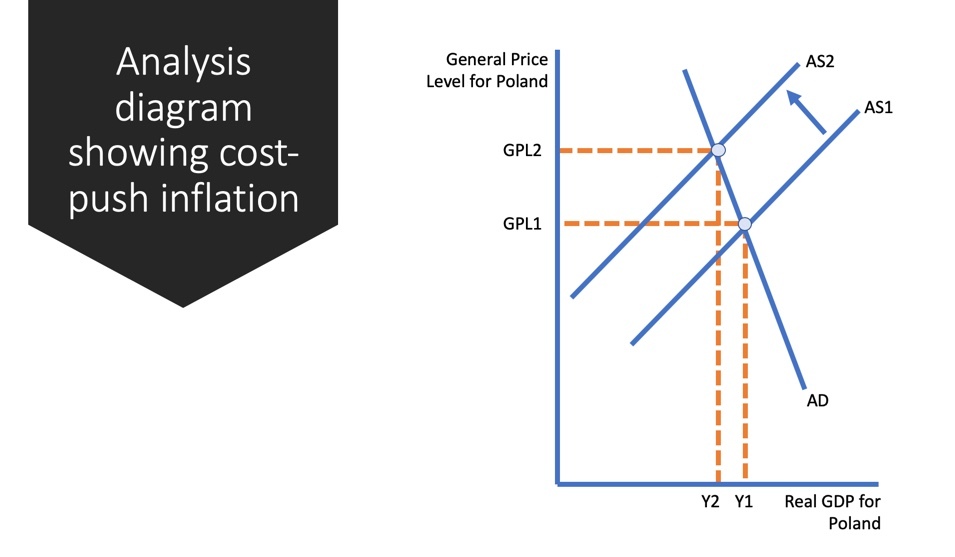"With reference to a country of your choice, evaluate policies that might be most effective in improving competitiveness."
This essay uses Poland as a contextual example, but you could just as easily use the UAE, UK or any country of your choice.
Once you have read the answer, discuss with a friend how you would change the analysis and evaluative points for your chosen country.
Analysis and application point 1
Competitiveness is the ability to sell goods and services successfully at a profit in overseas markets. Poland is a country inside the EU single market but retains their own currency – the Zloty. 25% of Polish exports go to Germany. One policy that might help to improve the price competitiveness of Poland is for the Polish central bank to intervene in the currency market to bring about a competitive depreciation against the Euro. This might be done by lowering policy interest rates or by intervening directly to sell Zloty and buy Euros. A weaker currency would make Polish products relatively cheaper in Western European markets, as a result, there might be expenditure-switching effects as Poland sells more exports and domestic demand for imports contracts since they become more expensive priced in Zloty. A consequence of this might be that Polish exporters will make more profits and this could then help them to increase capital investment. This in turn could cause an increase in productivity which would help maintain competitiveness in the long-term.
Evaluation point 1
Although in theory a depreciation of the Polish Zloty might improve the price competitiveness of the Polish economy, in practice the benefits might be eroded by some of the negative effects of a weaker currency. For example, Poland imports animal feed, vehicle parts and pharmaceuticals mainly from other EU countries. When the external value of a currency falls, then the domestic price of imported products almost inevitably goes up. This leads to a deterioration in the terms of trade meaning that Poland has to export more to pay for a given volume of imports. Crucially it can and does lead to a rise in cost-push inflation which reduces the real incomes of Polish consumers and also reduces the profits of Polish companies reliant on imports. Higher relative inflation can therefore make Poland less competitive inside the EU single market.
Analysis and application point 2
A second approach to improving competitiveness could be to introduce supply-side economic reforms to the Polish economy. Poland was once a transition economy and has used a number of market-friendly policies during the move away from socialism. These have included reductions in corporation tax and income tax – for example income tax rates in Poland are 18% and 32% contrasted with 20% and 40% in the UK. Lower tax rates have encouraged a rise in the number of business start-ups and inflows of foreign direct investment into the Polish economy. This investment has added to the country’s capital stock and has helped to increase labour productivity which in turn is a key factor causing real per capita incomes to rise. Inward investment also creates the extra productive capacity which increases Poland’s export potential. Foreign-owned firms are said to account for over half of Poland’s exports and the revenue from profits made by transnational businesses manufacturing in Poland also generates extra tax revenues.
Evaluation point 2
Market-friendly supply-side policies can improve the long-term competitiveness but they can also come into conflict with other macro objectives. For example, cuts in direct taxation on household incomes and corporate profits might contribute to more inequality and relative poverty within Poland. Higher inequality can actually damage competitiveness over time in part because a widening gap between the lower middle class and poor households compared to the rest of society might lead to more people being unable to afford good quality education and health care. If education outcomes suffer, then a country will not be improving its human capital as fast as possible and this can lead to structural problems such as higher unemployment and ultimately, lower labour productivity which is a key factor influencing price competitiveness.
Final reasoned comment / conclusion
In the long-term, competitiveness is mainly determined by the supply-side performance of a country. Therefore, I would argue that Poland should use policies that increase investment in education to build up human capital and also encourage more women into the active labour force. Poland actually ranks higher than the UK in the PISA rankings for Maths, Science and Reading. And Poland ranks third for best computer programming talent, ahead of the US and India. Investment in early years, secondary and higher education provides the best platform for improving non-price competitiveness in areas such as innovation, adoption of artificial intelligence and robotic technologies which will matter in years to come.

No comments:
Post a Comment